
NOW Articles Written By Members
Bullion And Coin Tax Exemption – Act Now!
Is There A Twenty Cent Piece We Can Add To A Collection
Capped Bust Half Dollars: A Numismatic Legacy
U.S. Innovation Dollars: Our Most Under-Collected Coin?
My 2023 ANA Summer Seminar Adventure
In defense of the American Women's Quarters
A look back in numismatic history – the Hicksville Silver Dollar Hoard
The proofs so few of us collect: Jefferson Nickels
A look back in numismatic history – a story too good to be true
Kilroy promotes war bond sales
Just passing through a short-lived bank
The Kewaunee Line Encased Coin Folder
Lyman C. Draper: Collector, Historian, Genealogist
>> More articles in the Archive
For more NOW Articles Written By Members,
<< More articles in the Archive
What do you know about the War of 1812?
by Jeff Reichenberger #1933
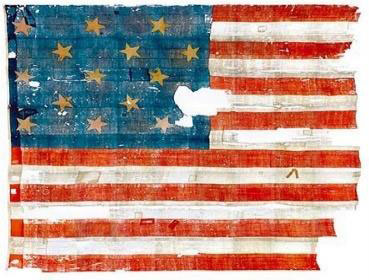
This Smithsonian-restored flag flew over
Fort McHenry during the bombardment
in 1814.
If you are like me, and most Americans, you probably know very little. It seems like the War of 1812 is but a footnote in American history. Most people remember a couple facts from their high school history class; 1) The British burned Washington/the White House; 2) The ‘Star Spangled Banner’ was written. That’s about it. Well, since this is the two-hundredth anniversary of the end of that war, I thought it appropriate to explore a few facts about the War of 1812, a surprising Wisconsin connection, and some interesting related coinage.
1812.
President James Madison and the United States declared war on Great Britain on June 18, 1812 for a number of reasons, including impressment of American sailors, the provoking of Native Americans unrest on the frontiers of America, and the outright seizure of American commercial ships. In addition, there had been long lasting trade restrictions brought on by Britain’s war against France, America’s ally during the revolution. That on-going conflict with Napoleon depleted the British of armaments, supplies, and man-power, prompting the taking of American commercial vessels, and the impressment of Americans into serving the British Crown. Impressment was a curious outrage as described by author Walter R. Borneman in his book; “1812, The War That Forged a Nation”:
How degrading to the young nation to have its ships stopped, its citizens seized and then made to serve in virtual imprisonment on board His Majesty’s warships. Oppressive as impressment was to most, the British government viewed the policy as essential to its mastery of the seas. British law permitted any able-bodied male subject to be drafted into immediate service in the Royal Navy – anytime, anywhere. This meant that a British captain who was shorthanded could put into any friendly or neutral port throughout the world and send a ‘press gang’ ashore to round up likely recruits. Frequently this was done among pubs and brothels, but press gangs also called on commercial vessels flying the Union Jack or flags of neutral countries, including the United States. Legally, such impressed recruits had to be British subjects, but practically, British citizenship throughout a worldwide dominion had many shades of gray. When, for example, did a British immigrant to the United States cease to be a British subject? The U.S. had naturalization laws, of course, but the British crown held to a simpler criterion: ‘once an Englishman, always and Englishman’. While Great Britain’s practice of impressment was longstanding, its use escalated as British manpower needs increased during the Napoleonic wars. Between 1803 and 1812 at least five thousand and perhaps as many as nine thousand sailors were impressed from the decks of American ships and forced to serve in the Royal Navy. Perhaps as many as three-quarters were bona fide American citizens. In 1807, then Secretary of State James Madison decried the entire practice of impressment as “anomalous in principle, grievous in practice, and abominable in abuse.” His demands that the practice cease met only with contempt from British authorities, particularly the foreign secretary, who scoffed: “The pretension advanced by Mr. Madison that the American Flag should protect every individual sailing under it…is too extravagant to require any serious refutation.” So impressment continued.-1
While sea battles on the Atlantic coast were a prominent theater of the war, land-water battles were fought along the American – Canadian borders following the Saint Lawrence River, Lake Champlain, and the Great Lakes. On the ground the British incited Native American tribes to fight with them against the American government, while British warships sailed down the St. Lawrence and moved in and about the Great Lakes on various fronts. A third area of fighting was in the south and the Gulf Coast at New Orleans, where there were major land battles fought with British and their Indian allies.
1813.
Early on in the war, the Americans recorded very few victories, having been turned back from invasions of Canada several times, and suffering defeats in the Great Lakes region at Detroit, Fort Michilimacinac (present day Mackinac Island, Upper Michigan), and Queenston Heights, Canada. In January 1813, in present day Michigan, General William Henry Harrison planned to attack British forces in Detroit by splitting his army into three groups and advancing at three different points. But one of the divisions, freezing from conditions, instead sought out food and shelter. The division, led by General James Winchester captured an enemy supply store at Frenchtown on the River Raisin and camped there. Being in a poor position for defense the division was vulnerable and was massacred by a surprise attack of 2500 combined Brits and Indians. Over 400 troops were killed and the majority of 80 wounded were finished off the following day.-2
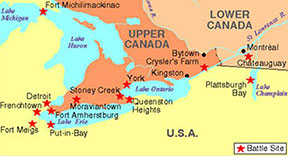
Many battles were fought in the Great Lakes Theater.
The spring of 1813 brought better fortune for the Americans in the Great Lakes arena. In May, General Harrison and his forces turned back a siege on Fort Meig in Ohio. The fort was a center of American activity and a prime target for British forces. The siege began in April and Harrison’s forces were outnumbered 4 to 1 but the Americans held their ground and when relief forces arrived the British- Indian army retreated after nearly a month of unsuccessful attacks.-3
While Fort Meig was being defended, the Americans launched an attack across Lake Ontario to the Upper Canadian capitol of York (present day Toronto). Landing on April 27, 1813, after ferocious fighting the British were forced to retreat. The Americans occupied York briefly and burned down Canadian Parliament buildings and their shipyard. Later in the war, in retaliation for the burning of York, the British would burn the Capitol building, White house and other government buildings in Washington D.C.-4
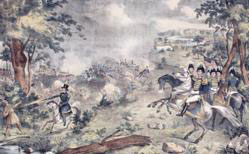
Battle of the Thames at Chatham, Ontario,
where
Shawnee War Chief Tecumseh was
killed during battle.
During the first half of 1813 the Americans were building up their war vessels in Lake Erie in order to control the lake and its ports which were occupied by British forces and Indian allies led by their fearless leader Tecumseh. In a grand victory for the Americans on September 10, under command of Oliver Hazard Perry, the British fleet was forced to surrender and the Americans were able to take control of Lake Erie and attack Forts Detroit and Malden. The British retreated up the Thames River, much to the chagrin of Tecumseh who preferred to stand and fight, but who nevertheless followed. On October 5th General William Henry Harrison’s American forces overtook the British-Indian alliance in the Battle of the Thames. Tecumseh was killed. The Americans held the Lake Erie frontier for the remainder of the war, while the British still controlled the Northern Michigan territories.-5
1814.
Fighting continued into the spring of 1814. In May British and Canadian troops scored a victory at the Battle of Fort Oswego, New York and managed to resupply their lines with a generous cache of everything from ammunition to food stuffs enough to last months.
Wisconsin.
It is astounding to think how widespread the War of 1812 was, from the remote locations of engagement on the northern borders, along the eastern seaboard, and south to the Gulf States, the battles raged in spite of the agonizingly slow transportation and communication of the times. For proof of this look no further than the skirmish at Prairie du Chien, Wisconsin. In May the Governor of the Mississippi Territory, William Clark (of Lewis and Clark fame) drove a small British-Indian force out of the Prairie du Chien area. It was a strategic location near the merging of the Mississippi and Wisconsin rivers. Clark built Fort Shelby there to help secure the region and fend off would-be assaults from the north on St. Louis, some four hundred miles to the south. But on July 17th a large British-Indian force came down from Mackinac and attacked Fort Shelby. After two days of fighting the outnumbered Americans surrendered and Prairie du Chien remained in British hands for the rest of the war, however, St. Louis was never attacked.-6
The British captured Washington on August 23, 1814 and proceeded to torch it in retaliation for the burning of York. President Madison made a narrow escape as the Library of Congress, the White House, the Capitol and Treasury buildings burned.-7
On September 11th, one of the most important battles of the war took place on Lake Champlain and the U.S. Fort at Plattsburg. The outnumbered U.S. fleet destroyed the British fleet, forcing the British to retreat back to Canada. The American victory was instrumental in the continued propagation of peace negotiations later in the year. Almost simultaneous to the Plattsburg campaign, after the British burned Washington, they headed north to bombard Fort McHenry at Baltimore. Americans held their ground and as the bombs lit up the night. One witness who was a detained lawyer trying to negotiate the release of an imprisoned medical doctor, was Francis Scott Key. He saw the flag still flying in the dawn which inspired him to pen a poem titled, “Defense of Fort McHenry”. Later retitled “The Star-Spangled Banner”, now 200 years later it is indelible in the American consciousness as our national anthem.-8
The battles of Lake Champlain and Plattsburg closed out the fighting on the northern frontier in 1814. In spite of growing British strength in Canada, the fighting there proved to be indecisive. Although Great Britain controlled Prairie du Chien, Mackinac Island, and Fort Niagra, and the United States controlled both banks of the Detroit River. Neither side could claim any monumental conquest, and command of the lakes was divided. Thus, after 3 years of fighting, the war on the Canadian – American frontier was a stalemate.-9
The War Ends.
Finally, on Christmas Eve 1814, the Treaty of Ghent (Belgium) was signed officially ending the War of 1812. Ironically, with news that traveled at a snail’s pace, one famous battle took place two weeks after the signing of the treaty. The Battle of New Orleans was fought on January 8, 1815. Future President Andrew Jackson commanded the Southern Theater and though they were once again outnumbered, the Americans recorded a rout, effectively slamming the door on the war and solidifying America’s resolve as a nation.
Coinage.
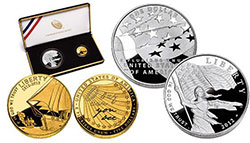
In 2012 the United States Mint issued two coins commemorating the bicentennial of our national anthem. The “Star-Spangled Banner” silver dollar and the “Star-Spangled Banner” five dollar gold piece, both in uncirculated and proof versions. The coins are available in the aftermarket. Current prices are approximately $45 for the silver uncirculated dollar and $50 for the proof version; the gold half eagle goes for $500 in either proof or uncirculated.
What coins were being struck by the United States Mint during the war years? From 1812 to 1814 the mint had a hard time getting raw materials to strike coins, at the same time the country was strapped for circulating coinage, resulting in a general shortage. Spanish milled dollars and its fractions, and other foreign currencies continued to be in use alongside the U.S. issues. The U.S. Mint tried its best to keep pace, but the workload was light during the war years. In 1812 only three denominations were issued; Classic Head large cents, Capped Bust Half Dollars, and Capped Bust Half Eagles, all of them designed by engraver John Reich. 1,075,500 cents were struck, 1,628,059 half dollars, and just 58,087 half eagles. In 1813 the mint produced 418,000 cents, 1,241,903 half dollars, and 95,428 half eagles. In 1814 the mint added Capped Bust Dimes to the meager list, striking 421,500, in addition to 357,830 cents, 1,039,075 half dollars, and 15,454 half eagles.
Just over 6 million coins struck for the entire three years. Obviously, the gold fives are rare and expensive, the 1812 coming in the most affordable at $3000 in Fine condition. The large cents are a bit easier to come by, and more affordable at around $250 in Fine condition. The one dime issue is scarce but can be purchased in the $130 range in Fine. Capped Bust Half Dollars are by far the most abundant and available coins of the years 1812 to 1814. These 200 year old large silver coins offer an excellent value at around $150 to $200 in Fine condition, not including rare die varieties.
Collecting representative coins from the War of 1812 can be fun, affordable, and rewarding. Of course a ‘complete’ set would be off-the-chart difficult and expensive to achieve, but a nice circulated large cent and half dollar of each of the years make a great short-set.
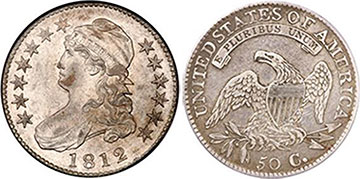 Capped Bust Half Dollar |
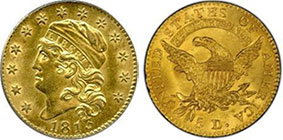 Capped Bust Half Dollar |
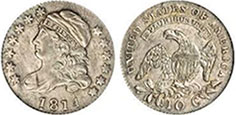 Capped Bust Half Dollar |
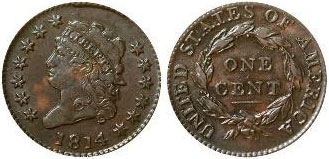 Capped Bust Half Dollar |
Interestingly, experts are able to actually identify varieties of half dollars that were struck very near the exact times of some events of the war using mint striking records and emission sequences. In a very interesting exchange between members of the John Reich Collectors Society, Bust coin expert and author Steve Tompkins responds to a Young Numismatist who had questions after visiting the Fort McHenry museum in Baltimore.
Young Numismatist Garrett Ziss writes:
On November 10, 2013, I visited Ft. McHenry after attending the Baltimore Whitman show the day before. During our tour, they mentioned that the cannon fire from the September 13/14, 1814 Battle of Ft. McHenry, could be heard all the way to Philadelphia. Of course, I immediately thought of the Mint striking Bust Halves while the employees wondered if our country would survive. I did not yet own an 1814 Capped Bust half dollar, but made it a goal to purchase one sometime in 2014 during the 200th Anniversary of the coin and the Star-Spangled Banner.
Today (September 13, 2014), the day before the 200th Anniversary of the Star-Spangled Banner, I purchased an 1814 Bust Half at a coin show in Lancaster, PA. It is a VF O-103 (R1), but it's a nice looking coin. (O-103 = Overton Bust Half variety, R1 = rarity rating. –Editor)
As soon as I got home with the coin, I looked up the emission sequence for 1814 Bust Halves. The O-103 is the next to last die marriage listed for 1814 out of a total of 9 die marriages. So, I think it's possible that it could have been struck during the time of the Battle of Ft. McHenry. September 14, 1814 was a Wednesday, so the Mint was in operation that day. My question to Bust Half experts is, if the information on the Mint delivery warrants is known for that year, is it possible to definitively tell what die marriage was being made on September 13/14, 1814?
Bust Coin specialist Steve Tompkins replied:
- The Mint delivery records show two deliveries of bust halves in September 1814.
- Delivery #725 - 9/12/1814 - 60,164, Delivery #727 - 9/19/1814 - 31,800
- Let's look at some facts and statistics to see if we can determine if your coin was indeed struck during the battle at Fort McHenry...
- Other than two R-4 die marriages, the other seven for the year are considered R-1 to R-3.
- The total number of bust halves delivered for 1814 is 1,039,075.
- If we just take this number and divide it by nine (the number of die marriages for the year), we get 115,453 coins struck per die marriage.
- There is no way to determine exactly how many actual coins were struck with each die marriage due to the unknown amount of attrition for each marriage.
- Even based on rarity we cannot narrow it down to a more accurate number, as an R-1 can only be stated as containing more than 1250 coins still in existence and this is open ended.
- But we can certainly state that the R-4 die marriages should contain 81-200 coins still remaining out of the original amount struck.
- The most often stated survival rate for early bust coinage is about 3%, however for bust halves I suggest it could be as high as 5-10%, due to banks keeping large amounts in their vaults.
- If we take the 10% number, then for the R-4 die marriages there should have been at least 810 - 2000 coins originally struck. Even if this number is lowered to 5%, we are looking at 1620-4000 coins originally struck.
- According to the Leaman-Gunnett-10 emission sequence, the last two die marriage struck in 1814 were O-103 & O-106. O-106 is currently an R-4 die marriage.
- Only those coins produced and delivered in the last delivery of bust halves for the year could have possibly been struck during the battle.
- The last delivery (#727) on 9/19/1814 contained 31,800 bust halves. If we subtract the possible amount of coins struck utilizing the dies of the O-106 die marriage, we still have at least 27,800 coins left over that could have been struck by the dies of the O-103 die marriage. As the O-103 is currently an R-1, most likely all of those remaining coins and some of the prior delivery were of the O-103 die marriage.
- So, the answer to the question is most likely YES...your coin could have been struck during the battle, but there were O-103's struck before and probably after the battle as well.
- This is a neat way to connect a coin to a specific point in history! -11
Well let me say, perhaps in the way a Young Numismatist might describe it, that this connection to history is not just neat; this connection to history is TOTALLY AWESOME! And it allows me to insert an exclamation point at the end of this article, and conveys an appropriate tribute to the War That Forged a Nation.
Endnotes / sources:
1 1812. The War That Forged A Nation. By Walter R. Bornman. Harper-Collins 2004
2 HistoryCentral.com
3 Government of Canada. 1812.gc.ca
4 Government of Canada. 1812.gc.ca
5 Government of Canada. 1812.gc.ca
6 The War of 1812. A forgotten conflict. By Donald R. Hickey. University of Illinois Press. 2012
7 Coinage Magazine. September 2013.
8 Coinage Magazine. September 2013.
9 The War of 1812. A forgotten conflict. By Donald R. Hickey. University of Illinois Press. 2012
10 By studying the changes in the impressions of the edge lettering dies Ivan Leaman and Donald Gunnet were able to determine the order in which the Bust Half Dollars were minted. Their original work was pubilshed in: America's Silver Coinage 1794-1891, Edges and Die Sequences on Early Half Dollars, Ivan Leaman and Donald Gunnet. Coinage of the Americas Conference, American Numismatic Society, New York, NY 1987
11 John Reich Collectors Society electronic newsletter. September 21, 2014 issue
Have an interesting numismatic topic you’d like to share with your fellow NOW members?
Send your article to evan.pretzer@protonmail.com today!!!